Fotoensayo de Yayo López
“Capital” Zaña, Chiclayo 2021

Land trafficking in Peru affects peasant and native communities, contributing to deforestation and biodiversity loss. Although the 1987 Peasant Communities Law protected lands as unseizable, imprescriptible, and inalienable, this inalienability was suspended in 1993 due to economic and political interests. The accumulation of capital, corruption, and legislation favoring the transfer of land to real estate developers and companies of dubious origin, with evident mafia ties, have facilitated the violent usurpation and dispossession of lands from these communities.
“Monumento a la victoria.” Plaza Dos de Mayo, Lima 2024

Plaza Dos de Mayo, located in Lima’s Historic Center, dates back to the colonial era as the Queen’s Oval, which was established in 1799. After independence, it was renamed the “Monument to Victory” to commemorate Peru’s victory over Spain in 1866. However, at the end of the 20th century, due to uncontrolled urban growth and informality, the square lost its relevance and became a space for vehicular traffic and plagued by crime. More than 250 historical pieces were stolen from the monument before its restoration in 2021, and restoration work is expected to be completed this year.
“Capital” Zaña, Chiclayo 2021

El tráfico de tierras en Perú afecta a comunidades campesinas y nativas, contribuyendo a la deforestación y pérdida de la biodiversidad. Aunque la Ley de Comunidades Campesinas de 1987 protegía las tierras como inembargables, imprescriptibles e inalienables, esta inalienabilidad se suspendió en 1993 debido a intereses económicos y políticos. La acumulación de capital, la corrupción y una legislación que favorece la transferencia de tierras a promotores inmobiliarios y empresas de dudoso origen, con evidentes vinculos mafiosos, han facilitado la usurpación violenta y el despojo de tierras a estas comunidades.
“Monumento a la victoria.” Plaza Dos de Mayo, Lima 2024

La plaza Dos de Mayo, ubicada en el Centro Histórico de Lima, tiene sus orígenes en la época colonial como el óvalo de la Reina desde 1799. Tras la independencia, se renombró “Monumento a la Victoria” para conmemorar la victoria peruana sobre España en 1866. Sin embargo, a finales del siglo XX, debido al crecimiento urbano desordenado y la informalidad, la plaza perdió su relevancia y se convirtió en un espacio de tránsito vehicular y afectado por la delincuencia. El monumento sufrió el robo de más de 250 piezas históricas antes de su intervención en 2021, y se espera que las obras de restauración culminen este año.
Related Articles
Editor’s Letter: Inequality
In celebration of the 30th anniversary of the David Rockefeller Center for Latin American Studies at Harvard (DRCLAS), ReVista is focusing on inequality.
The History of Inequality
For the last few decades, a strong consensus has held that Latin America is not only the most economically unequal region in the world, but also one where inequality has become structurally entrenched. Even in countries where income levels are relatively high by global standards, a small elite continues to control a disproportionate share of national wealth. This consensus reflects a broader shift in the development community and public arenas.
Waxing and Waning: Institutional Rhythms of Inequality
Zelia Maria Magdalena Nuttall was famous in her time, well-known as an archaeologist, an Americanist, an antiquarian, an ethnologist, a folklorist and “a lady scientist”; she was a woman “making it” in a man’s world from the 1880s to the 1930s. Deeply engaged in research about ancient civilizations in Mexico, she led a remarkable life as a pioneer in the evolution of anthropology as a field of study.



